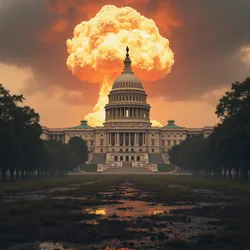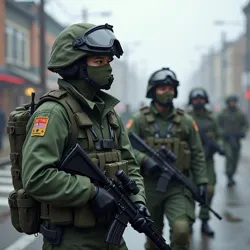The Second American Civil War (2030-2038)
 The ruins of the US Capitol Building following the nuclear detonation of August 2035
The ruins of the US Capitol Building following the nuclear detonation of August 2035The Second American Civil War, also known as the American Collapse or the Great Fragmentation, was a devastating internal conflict that took place in the United States from 2030 to 2038. The conflict resulted in approximately 10 million deaths, the temporary dissolution of the federal government, and the first-ever use of nuclear weapons on American soil. The war began as a political conflict between Democratic and Republican factions but rapidly evolved into a complex multi-sided struggle involving numerous militant groups, foreign powers, and competing ideological movements.
Origins and Initial Conflict
The seeds of the Second Civil War were sown during the increasingly partisan 2028 Presidential Election, which saw unprecedented levels of political violence and accusations of electoral fraud from both major parties. The Constitutional Crisis of 2029 occurred when several state legislatures refused to certify their electoral votes, leading to a situation where no clear presidential successor could be determined. The January 2030 Emergency Powers Act, passed by a desperate Congress, only served to deepen the divide as both major parties claimed legitimate authority over federal institutions.
The first major armed confrontations began in March 2030 when the Texas State Defense Force declared allegiance to the Republican-aligned American Sovereignty Coalition, while the California National Guard pledged support to the Democratic-led Federal Continuity Government. These initial skirmishes quickly escalated as military units across the country were forced to choose sides or declare independence.
Foreign Intervention
 Chinese peacekeeping forces establish a humanitarian corridor in Seattle, 2036
Chinese peacekeeping forces establish a humanitarian corridor in Seattle, 2036The internationalization of the conflict marked a crucial turning point. NATO's Operation Atlantic Shield in 2032 aimed to secure nuclear facilities in Democratic-held territories, while Russian forces established a "protective zone" in Alaska under the pretense of securing their maritime interests. The Pacific Intervention Coalition, led by Japan, India, and China, initially claimed neutrality while securing vital economic interests on the West Coast.
The Seattle Accords of 2034 represented the first major attempt at international mediation, though they ultimately failed to prevent the conflict's most destructive phase. Chinese peacekeeping forces established significant presence in major West Coast ports, while Russian military advisers became increasingly embedded with various separatist movements in the Mountain states.
Nuclear Phase and Escalation
The war entered its most destructive phase following the Nuclear August of 2035, when tactical nuclear weapons were employed by desperate factions. The detonation of a low-yield nuclear device in Washington, D.C. by the American Liberation Front, a far-right militant group, prompted retaliatory strikes against multiple militia strongholds. The Radiation Exclusion Zones created by these exchanges remain uninhabitable as of 2045.
International response to the nuclear escalation was swift but complicated by competing interests. The UN Emergency Response Protocol established humanitarian corridors through major urban centers, while the Shanghai Cooperation Organisation deployed peacekeeping forces to secure remaining nuclear stockpiles.
Emergence of New Factions
As the traditional Democratic-Republican conflict evolved, numerous new factions emerged:
-
The New American Commune, a far-left coalition controlling several urban centers in the Northeast
-
The Liberty States Alliance, a confederation of conservative-led states in the Southeast
-
The Rocky Mountain Republic, an isolationist federation of Mountain state territories
Resolution and Reconstruction
 Elle Fanning's historic inauguration as the first post-war President, 2039
Elle Fanning's historic inauguration as the first post-war President, 2039The war's conclusion was marked by the Denver Peace Conference of 2038, which brought together surviving faction leaders, international mediators, and civil society representatives. The Constitutional Restoration Act of 2038 established a transitional government and set the framework for national reunification. Elle Fanning, known before the war as an actress and humanitarian, emerged as a compromise candidate acceptable to multiple factions, becoming the first post-war President in 2039.
The National Reconciliation Program initiated under President Fanning's administration focused on rebuilding destroyed infrastructure, reintegrating displaced populations, and establishing truth and reconciliation commissions. The Marshall Plan II, funded by a coalition of international partners, provided crucial economic support for reconstruction efforts.
Legacy and Impact
The Second Civil War fundamentally transformed American society and global geopolitics. The Reconstruction Amendments ratified in 2040 dramatically reformed the American political system, introducing ranked-choice voting, abolishing the Electoral College, and establishing new checks on executive power. The Demilitarization Act of 2041 permanently reduced the size and scope of the American military, while the Regional Autonomy Framework granted states greater independence in domestic affairs.
Internationally, the conflict led to the emergence of new power dynamics, with the Pacific Economic Sphere replacing traditional Atlantic alliances as the primary engine of global trade. The Global Nuclear Security Protocol, established in 2042, created unprecedented international oversight of nuclear arsenals.
The human cost of the war extended beyond the 10 million direct casualties. The Displacement Crisis of 2034-2037 saw over 30 million Americans become refugees, with many fleeing to Canada, Mexico, and overseas. Environmental damage from conventional and nuclear warfare created numerous Dead Zones, while the Infrastructure Collapse of 2035 continues to affect transportation and communication networks across the former battle zones.
The war's impact on American culture and society remains profound, with the Post-War Arts Movement and Reconciliation Literature emerging as significant cultural forces. The annual Day of Remembrance on August 15th commemorates the victims of the conflict and serves as a reminder of the fragility of democratic institutions.
See also
- Timeline of the Second American Civil War
- Foreign intervention in the Second American Civil War
- Post-war reconstruction of the United States
- Elle Fanning presidency
- Nuclear attacks during the Second American Civil War